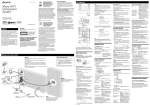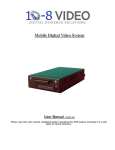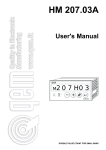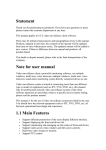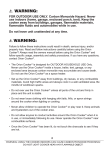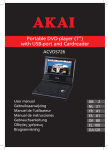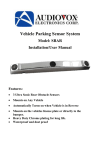Download Install Guide - 10
Transcript
Mobile Digital Video System User Manual (102sd) Please read this user manual completely before operating this DVR system and keep it in a safe place for future reference. -1- CD-ROM The CD below contains the viewer software needed for playback on your computers. The default login and password has not been set. When running the program, just click ‘OK’. Once in the program, you can assign a login and password if desired. Also on the CD is a copy of all manuals. The first time you insert the CD it will automatically run the install for the software. Once installed, if you need to access the manuals, just click cancel at the install prompt. You can then access the files on the CD through your file manager like you would any other CD. -2- Caution! You, as the driver, are solely responsible for the safe operation of your vehicle and the safety of your passengers according to the US and local traffic regulations. Do not use any features of this system to the extent it distracts you from safe driving. Your first priority while driving should always be the safe operation of your vehicle. 10-8 Video cannot accept any responsibility whatsoever for accidents resulting from failure to observe these precautions or safety instructions: 1. This product utilizes high voltage. Any unauthorized modifications or damage to the products may result in electrical shock. Handle all components with care. Inspect regularly for damage to components and cabling. 2. You shall be responsible to ensure that the installation of this product does not void or affect the vehicle manufacturer’s warranty. 10-8 Video, or its branches are not liable in full or in part for improper installation resulting in loss or damage to your property, or for voiding all or part of the vehicle manufacturer’s warranty. 3. Do not apply excessive force to any of the components contained within this kit. Excessive force used before, during or after installation that results in a damaged or non-functional part shall void all warranties. 4. Please follow the procedures from this installation manual. Improper installation or modification of this product shall void all warranties. -3- Section 1: Installation Power Distribution Block The power distribution block is included for your convenience and is not required that you use it. It may make for a cleaner installation by requiring only one power and one negative lead from the vehicle and will then power the 4 components in our system. It uses ¼” male spades for the input and ¼” female spades for the output. Use at your own risk. 10-8 Video is not responsible for it’s use or misuse. If you decide to use it, be mindful of polarity with each connection! -4- DVR Installation The installation of the 10-8 Patrol Car video system breaks down to some very simple steps. The basic connection for video and audio are very similar to a VCR or DVD player. The one area that differs from what you may have done in the past is the connections for the alarm inputs . You will need a 12v power source for the system. 10-8 video includes a power distribution block for your convenience. It simplifies the installation and makes for a cleaner install, since just 1 power and 1 ground will be needed. We recommend that the power source be from switched power that is only hot when the vehicle key is in the 'ON' position. Digital Video Recorder Unit (DVR) The first thing you will want to do is locate where you want to install the DVR. The small size of the unit makes that much easier than just a few short years ago. Your first choice should be in your main equipment console if you have one. If there is no room in the console, the next areas to consider are on either side of the console, in the dash or under the dash. Try to keep the unit in sight of the driver where they will be able to use the I/R remote more easily. If needed, the DVR ships with 2 small brackets for mounting. Connect the red/black power connector to the back of the unit by inserting into the square receptacle on the rear of the DVR. Insert until locked. The Black lead needs to be connected to a chassis ground and the Red lead will connect to 12v ‘ignition on’ power source. -5- Emergency Lights & Manual Activation Setup There are 3 leads coming from the sensor harness. Each lead will activate the record function when 12v is applied to any of the 3 leads. In a typical patrol car installation, 2 of these leads will be used. Connect the green lead to the output side of you control box for your pursuit lights. This lead will simply detect when 12v is present and activate the recorder. You can simple connect it to any of the lights that are used for emergency traffic. This way the recorder will start anytime you are running emergency traffic. Depending on the type of switch box used, there may be a place to connect at the back of the switch box. If not, simply connect to any lead that goes to a 12v light that is activated when you turn on the emergency/pursuit lights. The orange lead can now be connected to a manual switch that you will activate when you want to start the recorder without lights activated. You can use any switch of your choosing that will provide 12v to the lead. Many of the newer control boxes used by departments will have a blank switch that is not being used. These are a great choice for the manual switch. If none are available, a simple toggle or rocker switch mounted in a convenient location works well. These wires are very sensitive and care must be taken that you do not connect to a wire that has low voltage all the time. The recorder will detect voltage and activate the recorder. Wireless Mic Receiver: Once you have a location for the DVR, locate a convenient spot for the Wireless mic receiver. That is the small box with the collapsible antenna. This will not have to be readily accessible once it is installed so you may want to put it under a seat, under the dash, in the trunk, or since it is so small and light, just Velcro it to the firewall or anywhere else that is convenient for you. It is recommended that it be in the front ½ of the vehicle for the best reception. Once mounted, plug in the power lead and connect the red to your 12v power source and negative to chassis ground source. There is a black cable in your kit that has a phono plug on 1 end and RCA on the other. The phone plug will plug into the back of the receiver, and the RCA will plug into the matching RCA plug on the Audio/Video input cable from the back of the DVR. As a final step, be sure the volume adjustment on the receiver is turned clockwise as far as it will go. -6- Mirror/Monitor Install: Now mount the mirror/monitor over the existing mirror. A good place to run the wires for the mirror is to tuck them in the front edge of the headliner and down the passenger side pillar post. The covers on most modern pillar posts snap in to place and are easily removed with plenty of room. Run the wires down along the door edge and under the glove box to the location of the DVR. Connect the RED spade connector to your 12v power source and the BLACK to your chassis ground. Now plug the yellow RCA connector labeled ‘Video1’ to the yellow RCA female connection of the 2 leads coming from the A/V Output port. The Audio out is generally not used as audio playback is not usually needed in the vehicle. If you wish to use the audio out, you will need to connect to a powered speaker with volume control. Camera Install: Mount the camera high and just right of center on the windshield. This is normally to the rear and slightly to the right of the rear view mirror/monitor, as in the picture below. Leave just enough room for the camera to rotate 180 degrees in either direction. The mount is an excellent commercial mount and is very strong when properly attached to the windshield. Make sure the glass is clean and press in on the center button of the mount. While pressing in, pull the locking lever up and over the center button to lock it in place. Now run the included cable along side the mirror/monitor cable to the DVR. Plug the BNC video connector from the camera to the BNC video-in cable from the DVR. Run the power leads from the camera to the power distribution point you are using with RED going to your 12v power source and the BLACK to the chassis ground. -7- Basic Wiring Diagram 1. DC power input socket 2. Delay time select switch 3. Sensor port 4. A/V input connecting port (camera & Wireless Mic) 5. Function expansion I/O port 6. A/V output port (mirror/monitor) Optional Spkr. 7. Alarm trigger wires connecting port 8. G-sensor connecting port 9. External signal connecting port (not used) -8- -9- - 10 - - 11 - After Install Set-up Be sure the SD card is properly inserted in the DVR unit and start the car or turn the key to the accessory position to power up the system. After approximately 5 seconds, the system will come on and go through a brief self test. The SD will automatically be formatted if not already formatted. If the monitor is turned on, you should now see a picture from the camera. Take a moment and align the camera for the proper view. We recommend a slightly right of center view. This allows for a centered view of a vehicle during a traffic stop if you use a left offset during your stops. If not, align the camera to your personal preference. ENTER YOUR Unit ID: Press ‘Menu’ on the remote and using the arrow keys scroll down to ‘Sub Menu' and press the ‘enter’ key (the key centered between the arrows on the remote). Scroll to the DVR ID section and enter your unit or badge #. This is the ID that will be displayed in recordings to identify which unit made the recording. Up to 8 characters can be used here. After putting in your ID #, press the ‘Menu’ key until you are out of the menu system. SET DATE/TIME: Press the menu key and use the arrow keys to scroll down to 'Date/Time Setup'. Using the arrow keys you can scroll down to each section you need to change. You will then use the keys on the right side of the remote to change values. When everything is set for your location, press the 'menu' key until you return to the live view. Admin Options: There are a couple of things that administration will need to decide as a matter of policy for the department in regards the camera systems: 1st. There is an option in the main menu that will lock out the individual officers from making changes in the system options. It will still allow them to playback videos in the vehicle, but will not allow them to call up the system menu. 2nd. Also in the menu is the option to automatically record for 30 seconds each time the vehicle is started or the key turned on. 3rd. If you opted for the GPS and G sensor options, you can set the G force level that the recorder will automatically begin recording. We recommend around 2Gs. And if you have the GPS option, there is a GPS menu setting that allows you to set a vehicle speed that the recorder will automatically activate at. Some departments will set this at state maximum or a little over. Your system is now '10-8' and should begin recording when you activate your lights or the manual switch. The system is set to pre-record for 30 seconds. This means that system is always recording in a 30 second loop. When you activate your lights or use the manual switch, it actually began recording 30 seconds prior to activation. - 12 - Front Panel 1. IR remote control receiver 2. Lock 3. IR remote control receiver 4. Power indicator 5. Record indicator 6. A/V output port 7. G-sensor reset button 8. Record button 9. SD card slot I/R Remote Control Record Menu Up Down Right Left Enter Value Up Select Value down Stop Sound Play (Number 9) Rewind F Forward (Number key 0) Pause - 13 - In-Vehicle Video Playback You can watch previously recorded events in the vehicle by using the remote control. Point the remote at the DVR and press the 'play' button. You will see a search screen on the monitor and will now press the 'down arrow' once to highlight 'Event Search' and press 'enter'. You will now see a list of events that have been recorded starting with the latest at the top. Use the arrow keys to select the event you wish to watch and press the enter key. You video will begin to play and using the remote you can FastForward, FastRewind or Pause the playback. When you are ready to stop the recording, press the 'stop' key to return to the event list or press the stop key again to return to the live view. Keep in mind that if you are currently recording an event, you can still playback an event without interrupting the recording. - 14 - 10-8 PC Player Software Install the 10-8 Player software by installing the CD supplied with your system. If the CD is not available, you may download it from the 10-8 Video web site by entering the following address in your browser: http://www.10-8video.com/downloads.html Scroll to the bottom section and look for the link to the 10-8 Player. When asked, select ’run’ and the software will install. Double click on the 10-8 player icon to load the player. After it has downloaded, run the program to install on your PC. Double click on the new icon on your desktop to run the program. If a box appears asking for a password, the default login and password are both 'root' without the quotes and all lowercase. You can then go into 'Account Management' to change the login and password. How to play back a recording: (1) Click on ‘New File Search’ Button - 15 - (2) Click on Browse and select the file location. If the files are already on the hard drive, just select the folder location or if on the SD card, select the drive letter associated with your card reader. (3) Select a file on the next screen and select ‘Open’ to play. Or select ‘Search All Event’ to bring up a screen with all events that were recorded sorted by date and time. - 16 - Select the event you wish to play and select ‘Open’. You will now be in the main playback window: - 17 - The Play back panel at the bottom of the screen works similar to a DVD or VCR panel. You can speed up, slow down, and view frame by frame with this panel. You can also use the slider button under the video to quickly go forward or backward in the video. The 2 arrows on either side of the pause button will play the video in slow motion. Repeated use of the pause button when paused will advance frame by frame. At the bottom left of the screen, the ‘Time Line’ buttons will allow you to select the scale that is displayed at the bottom of the video window. This timeline will display recorded events in red. The calendar at the lower right of the screen will display the days in red that have recorded events. Clicking on one of the red days will bring up the videos of that 24 hr period. On the right side of the screen ‘All Event Search’ will display a list of all of the events on that SD card or folder. ‘Current Event Search’ will bring up the events of the 24hr period currently being viewed. The GPS related buttons will only apply if you have the GPS receiver option installed in your vehicle. If you have the GPS option installed, you should see your GPS coordinates displayed on the top left and your vehicle speed on the bottom left. - 18 - If you have another program that reads GPS data, you can use the ‘GPS Data Export’ button to create a file that can then be read by your program. Pressing the ‘GPS Overlay Button’ will bring up a Google Map and a vehicle icon on the map that will move along with the video you are playing. This map and icon will display the exact positions of the vehicle that made the recording. The +/- buttons on the map will allow you to zoom in or out as needed. Using your mouse, you can click and drag the overlay window to a different area of the screen. The text box that follows the vehicle icon on the screen is displaying the date and time along with the speed of the vehicle at the time of the recording. To close the overlay window select the red X in the top right corner. NOTE: Your computer must have access to the internet to use this feature, as the map data is pulled from the Google server in real time. Saving Events to a File: Before discussing the ways you can save an individual event, it is important to understand how the file will be used later. If you are saving an event for court, it is highly recommended that you use the ‘Create File’ option to do so. The reason for this is that the 10-8 System records video in a proprietary format. This is done to maintain evidence integrity. There is no commercially available software to manipulate the videos in any way and this is the reason you want to keep videos in their original format. - 19 - Create File: Before using either the ‘Create File’ or ‘Create Media’ options, you will first need to write down the exact times that you want to record. When the event you wish to save begins to play, make a note of the exact date/time of the beginning of the vent. Now move the slider over or use the FF or FR buttons to get to the end of the event and make another note of the time it ends. Now select the ‘Create File’ option and the following window will appear: Starting at the top of the window ‘Select Path’ you will put in the path to the drive and folder you wish to save your file to. To make it easier, you can you the ‘Browse’ button on the right. When the path is correct go to the next box ; ‘File Name’. Here you will want to name the file so that is easily recognizable later when you want to find it. For example, if you are saving a DUI event where ‘JONES’ is the suspect. You might want to name it something like ‘Jones DUI’. By default, the system will name it based only on the date and time of the event. Just below the window next to ‘Start Time’ you will notice a long grey box with a slider on the left. As you click and drag on the slider you will see the date and time change next to ‘Start Time’. When you get it close to where the start time is, you can use the arrows at each end of the slider box to move in small increments. When you have got the Start Time where it needs to be, repeat the process on the next slider box to set the ‘End Time’ window to where it needs to be. After you have double checked that the times in both Start Time and End Time widows are correct, press the large ‘Backup File to PC’ button to save the file to the folder you selected in the path window. - 20 - Create Media: This option is best used for in-house training or sharing videos with others. It is not recommended for court for the reasons explained on pg15. Like the ‘Create File’ option, make a note of the date/ time of the beginning and end of the event you wish to save. Select the ‘Create Media’ option and the following screen will appear: The process to create a Media File is very similar to the Create File process on the preceding page. As you are using a single camera system, leave the mode set to ‘Channel 1’. The next step is to select the file format you wish to create: WMV, AVI or JPEG. WMV and AVI files are both popular formats and can be played on most any other computer. (Be very careful with the JPEG option! This option will create individual .jpg images from each frome ot the video. It is best used for a time span of just a few seconds when you wish to pick out detail from a segment of the video. Use the ‘Set Convert Quality’ slider to set the quality of the video file. 75% is a good starting point. As you set the quality higher, it will create a larger file and take longer to save. Likewise, a lower setting will create a smaller file and take less time to convert. Now use the ‘Browse’ button to select the folder where you wish the file to be saved. You can then type a file name in the next box for the name you wish to give to the saved video. You can now use the sliders under ‘Set Start Time’ and ‘Set End Time’ to match the times you noted for your event. When the times in these windows match with the event you wish to save, select the ‘Convert File’ button to save the file where you selected in the path option. - 21 - Password: Selecting this option will bring up the following window: From here you can select the drive letter where your videos generally originate. At the bottom of the box is where you can set a login and password for the software. This is the window that appears when you start the software. If you wish to not have a password required, make sure that all of the boxes are left blank and select ‘Confirm’. This will set the account and password to blanks. When you start the program the next time, the box will still come up asking you to put in your account and password, but selecting ‘OK’ will start the program. Snapshot: This option will allow you take a still frame from the video and save it as a .jpg image. This is beneficial when you wish to preserve a frame from the video. This could be a suspect image or other evidence you wish to view and print later. If needed, you can press the ‘Show Text’ button to remove the text from the screen before saving. - 22 - Archiving Your Videos Department policies on archiving videos vary a great deal. From departments with no policies to departments with archiving requirements of 30 days to 1 year to forever! In today’s digital environment, archiving videos is much less expensive and easier than it was a few short years ago with tape based systems. As of this writing, 1 terabyte drives are less than $100 and will store a great many videos from a lot of officers. Regardless of the actual time frame you wish to keep your videos, we will outline below 1 recommendation that has worked well for many departments. Of course, you are free to modify or come up with a way that works best for your department. Decide which PC will be used for archiving. Bring up the file system of that computer. On many systems that can easily be done by holding down the key with the 4 little squares that look like the Windows logo and pressing the ‘E’ key. Click on the drive letter that will store the videos and you will see the folders currently on that drive. You will now want to create a ‘New Folder’ and then give it a name; maybe something like ‘Patrol Videos’. Now, inside that folder create a new folder for each officer that has the 10-8 System in their vehicle. A good name for each folder would be their vehicle or badge number. With each officer now having a folder for their videos only, you can now establish a policy for when they archive. We recommend that you have your officer bring in their card or notify you when their system displays that they have about 10% remaining. When you have their card in hand, put it in your SD card reader and bring up the file system again. Go to that officer’s folder and create a new folder and name it with the current date. For example ‘051510’ for May 15, 2010. This will make it easy to find a video later on when needed. As each officer’s folder grows, you can easily locate the time frame of the video by the folder name. Now that you have the folder named, use your files system to drag ALL of the files on the SD card into that new folder. Do not delete or format the SD card. Just return it to the officer’s vehicle and insert it back in the DVR. It will still be at 10%, but when it reaches 0% it will start back at 99% and overwrite the oldest events first. This gives you an additional backup until the files are overwritten. When it gets back down to 5-10%, just repeat the process in a new folder of that date. - 23 - 301 Market St. E. Suite F Fayetteville, TN. 37334 Fax 931-233-1263 Go To www.10-8video.com for the latest information and products from 10-8 Video; Your ‘Digital Evidence Solutions’ Headquarters! - 24 -
























